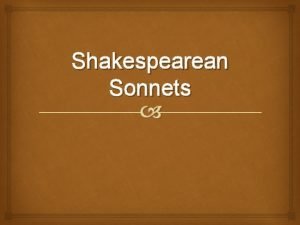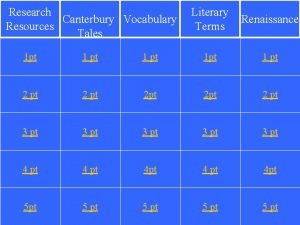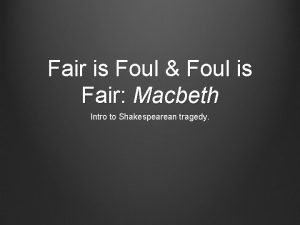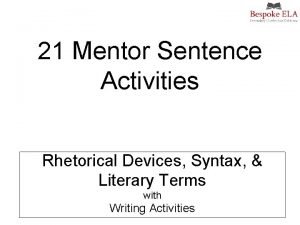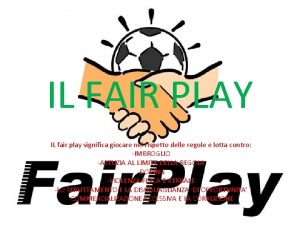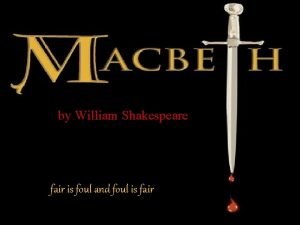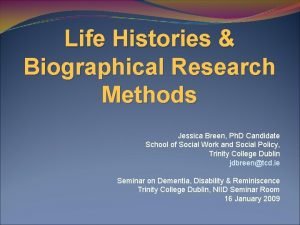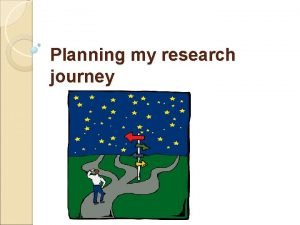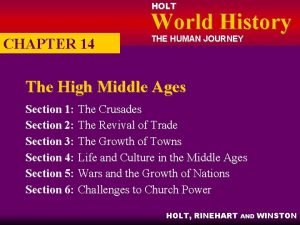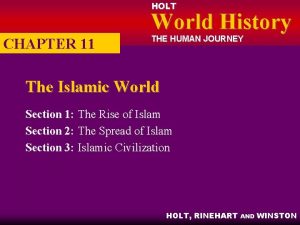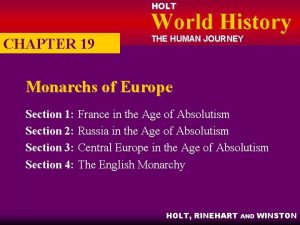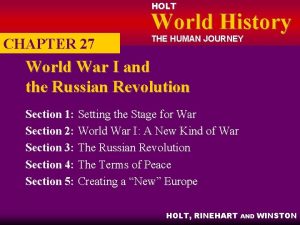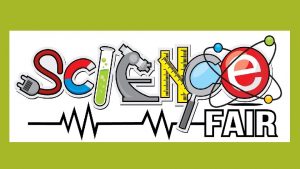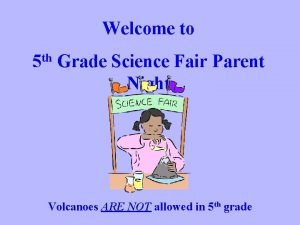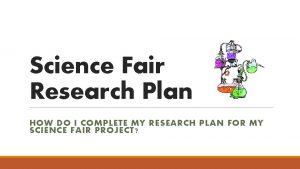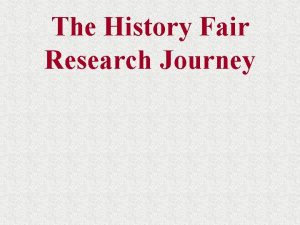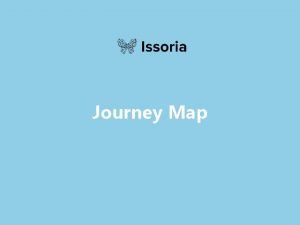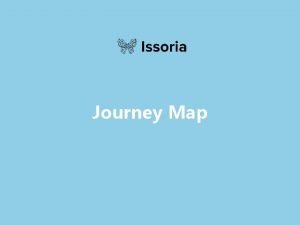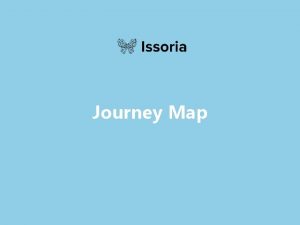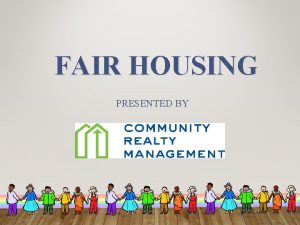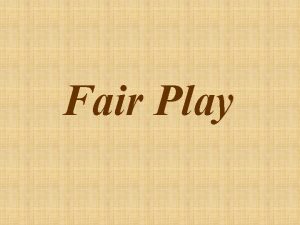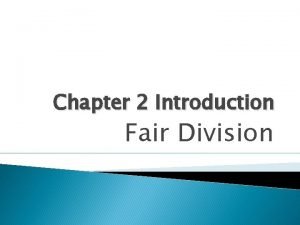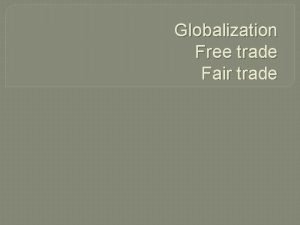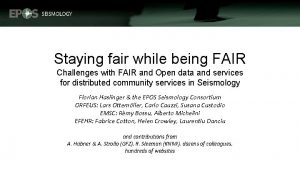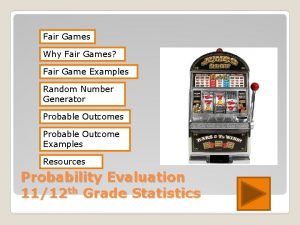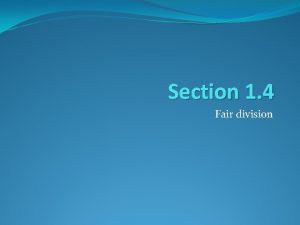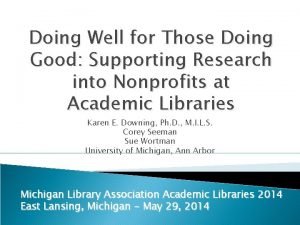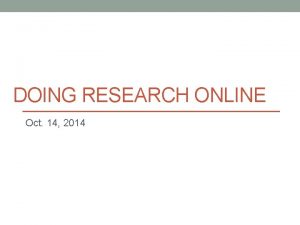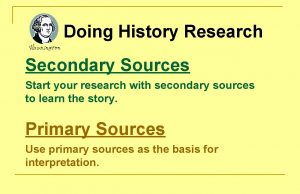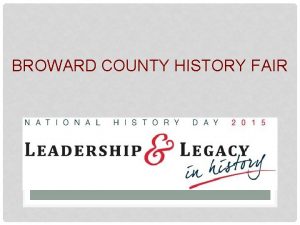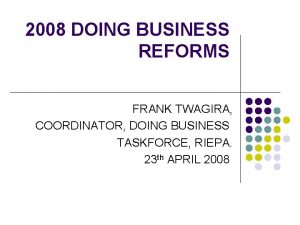The History Fair Research Journey Doing History Fair


























































- Slides: 58

The History Fair Research Journey

Doing History Fair is like being a detective • Untangling a mystery (History Fair historical question and thesis) through research • Finding evidence • Building a case DN-0078953, Chicago Daily News negatives collection, Chicago Historical Society

Each stage of the research journey calls for different sources that move from the general to the specific, from secondary sources to primary sources. STAGE 1: General Secondary Sources Encyclopedia Textbook General history books One or two primary sources STAGE 2: ON TOPIC Secondary Sources Chicago History books and magazine articles, general history books on topic Primary Sources Found in books, magazines, digitized special collections or online databases and portals Make History Here! STAGE 3: IN DEPTH Secondary Sources Specialized, narrow-focused books and journals by experts, historians Primary Sources Actual papers and records in archives and special collections, more online digitized primary sources, interviews with participants, witnesses

Stage 1– Basic Knowledge TYPES OF SOURCES • General and Specialized Encyclopedia (includes Wikipedia) • Textbook • General history books • One or two primary sources TYPES OF QUESTIONS • Who are the key people? • What are the key events? • Where does it fit on a larger timeline? • What information sparks my curiosity and helps me narrow my topic?

Stage 2 – Narrowed Topic TYPES OF SOURCES TYPES OF QUESTIONS Secondary Sources • What is the context? • Why and how did these events happen? • What are the causes and effects? • What were the various motivations, perspectives, and concerns of the people involved? • How does this story fit into the big picture? • Chicago and Illinois history books and magazine articles • General history books on topic • Popular history magazines and periodicals • Documentaries • Museum exhibits Primary Sources • Available from books, magazines, digitized special collections or online databases and portals

Stage 3 – In-depth TYPES OF SOURCES TYPES OF QUESTIONS Secondary Sources • Specialized, narrow-focused books and journals by experts, historians • Interviews with experts and historians • What key arguments do historians make? • What do you think matters about this topic? What story are you going to tell? • What are the core issues? • Why does this topic matter-what is the big picture? • What is the long-term historical significance of this topic? Primary Sources • Special collections and archives, more online collections • Interviews with participants, witnesses

Key Sources for Research – Internet • Online databases • Primary sources • AVOID websites as secondary sources unless credible authors – Libraries • Secondary & Primary Sources from books, journal and magazine articles, and special collections – Historical collections at libraries and archives • Primary sources – Interviews • Witnesses, participants = primary • Experts, scholars, second-hand = secondary

ON-LINE DATABASES “The Internet” PORTALS & INVISIBLE INTERNET WEBSITES

Online Databases • Secondary sources for basic information, background, and overview. • Some will contain primary source materials • Some will give citations— then need to see to get the journal (often on microfiche/microfilm) • Some will have full-text, PDFs of articles Examples of databases: • EBSCO • J-Stor • Gale Virtual Reference Library • Biography in Context • History Research Center • Archive Grid • Encyclopedia of Chicago • Explore Chicago Collections • Digital Public Library of America

Google, Yahoo, and Bing are NOT sources – they are Search Engines (It might help to think of them as library card catalogs… that get you to the sources you need. )

Deciphering a URL • • • . edu = educational websites. com = commercial and general websites. org = organizational websites. gov = government websites. net = network-based websites --which can be trusted (credible)? ? ? Who wrote the piece and why is she/he an expert? When was the site updated? Who “owns” the site?

Are you working for Google or is Google working for you? • Getting 2, 000 hits on your query? • Pulling up sites that give you the same old, over and over again? • Not sure of the website’s credibility?

When you use Google: Command Google…. • Group words together: “Juvenile Court History” • Use 2 commands together: “Juvenile Court History” + Chicago • Specify type of website: “juvenile court history”: gov or “juvenile court history”: edu ALSO: Use the “Advanced Search” options. • Use metacrawlers and directories…. • Google Books and Google Scholar…. .

WHAT’S UP WITH Wikipedia? It’s a beginning reference -just like a general encyclopedia which means its only background information – not a valid History Fair secondary source. The citations, however, can be useful in finding real books and articles.

Secondary Sources are First!* *but you will find primary sources along the way, too!

A Superior Detective will… • Keep track of your leads: What keywords, terms, or tags you used and star those especially helpful. • Keep organized and use active notetaking! Use your own words and ask questions as your take notes. • Get all bibliographic information at the same time. You may think you’ll remember, but. . . Info o r quote s CITA TION Ques t & ide ions as

Always start your History Fair research: Available as a book at every public library or online @ www. encyclopedia. chicagohistory. org • Key, basic information • Timeline for context: social, political, cultural, economic factors • Themes to help understand bigger picture: for example, Americanization, racism, contested space, political cultural • References to quality secondary sources • Primary sources, maps, graphs

Links to other entries Primary source Author Important secondary sources recommended by author

Chicago Public Library Harold Washington Library, Local & Regional Branches, & Online • Books, magazines, journals, newspapers • Online databases with secondary & some primary sources • Online primary sources • Special collections with one-of-a-kind or rare materials for primary sources—Harsh Collection at Woodson & Sulzer regionals & downtown at the HWLC.

Strategies to get the most out of CPL online • Research the catalog at home or school computer so when you go to the library you can go right to the books or journals you need • Save your selections in “My Shelves” so that you can go directly to the books • Many online databases are available at HOME with a valid CPL Library card (or e-card) or at neighborhood branches.

CPL has two “pathfinders” to support History Fair research: 1. Chicago History Fair 2. Online Resources For Teens History Fair

Shows the library, location, and call # -- an efficient way to find similar topics If not at your local branch, place a “hold” on book and it will be delivered to your local library Books are categorized a number of ways. Use subjects to find related titles

Another way to use the CPL catalog The “topics, “ “tags, ” and other groups that appear on the side can lead more materials on the topic – choose what seems most relevant for your needs

Some material at CPL will qualify as primary sources.

BIG TIP: “Follow the Footnotes” THE BEST SECONDARY SOURCES CAN LEAD TO: § OTHER KEY SECONDARY SOURCES § WHERE TO FIND PRIMARY SOURCES Such as special collections or newspaper and magazine dates… § AND WILL OFTEN CONTAIN PRIMARY SOURCES STUDENTS CAN USE!

SECONDARY SOURCES: Journal and newspaper articles, books, & dissertations PRIMARY SOURCES: A person’s “PAPERS” in Special Collections or newspaper articles written at that time

Why use history journals? • Gain background information • Learn other historians’ interpretations – this is called “joining the conversation” • Get the gist of the historian’s work without reading the full book • Use the primary sources that are often included as evidence in the article • “Follow the footnotes” that can lead to more secondary and primary sources

History journals such as Chicago History or the Journal of American History contain both secondary & primary sources These kinds of journals are INDEXED in “America: History & Life” and J-Stor.

J-STOR offers FULL TEXT quality secondary source articles by historians and other scholars dating from as far back as 1899 until the 1990 s. Now available at all CPL branches (but not from home)!

Journal Articles

Keyword Search

Amazon. com can help find recent books that may be important for your research. Many new books will show Table of Contents or Index so you can figure out if you need to look at it. Also, “other books bought” and tags can take you to more sources to look for at the library. Do you think CPL will have this book?

Primary Sources Material made at the time are the real “voices from the past. ” Depending on the topic, you can search online, at libraries, archives, or special collections, organizations and businesses, and perhaps even in your own home.

Primary sources are the “stuff of history” that make history come alive and are the evidence for your argument.

Portals lead to the websites that contain primary sources… For example…

Library of Congress

Explore Chicago Collections

Library Congress contains more than photographs!

The best websites are composed mostly of primary sources. In some cases, they are subjectbased and organized.


J-STOR: available online AT any Chicago Library branch Why is this article a primary source? What might you gain from reading it?


Students in Special Collections?

! S YE

Where to Find Special Collections? Check out the Resource Directory on the History Fair website:

Websites often list what RECORDS & PAPERS they hold. The librarians and archivists know their collections best, so call to talk about research before going.

Some websites even have “finding aids” so you can see exactly what is in the collection!

Chicago Historical Museum Research Center. Students must make an appointment to use the research center! Visit www. chicagohistory. org/research-center-appointment-history-fair-students/ to fill out the form online.

Once you have registered for an appointment, a Research Center librarian will contact you. That’s a good time to ask if they have a History Fair Bibliography for your topic! Use CHM bibliographies to find as many sources as possible through CPL, so when you go to the resource center at CHM, you are looking at sources you can’t get elsewhere!

Before you show up for your appointment, do a little background research! The real treasures are in the Manuscripts & Papers, printed catalog, and photo archives. Check out “Archie” to begin your search into the special collections. A CHM librarian’s support is crucial.

Government Documents • Municipal (city) Reference Library & Government Documents at CPL has city documents such as city council proceedings, laws, reports from city agencies, and proposals. Government Documents has laws, executive orders, congressional hearings, and other material from the state and U. S. government. • National Archives & Records Administration (NARA) has one of its six branches in Chicago & YOU can use any of the material such as court documents, immigration papers, reports and photos from local agencies, military records, and patents.

A word about INTERVIEWS • Primary source = a witness or participant • Secondary source = an expert or scholar or someone telling you what someone else told them… ALWAYS DO BASIC RESEARCH BEFORE YOU INTERVIEW!

Visit Historic Sites & Museums Going to the places where history happened or taking a close look at the "real stuff" in museums helps students visualize the history that they've been researching and is an exciting part of doing History Fair. The guides at historic sites and museums can offer many insights – still, they are secondary sources.

Write down the information for your source as you go along. The Annotated Bibliography An annotated bibliography is composed of the citation and a brief description of each article or book listed and how it was used. The description helps the reader evaluate the content and usefulness of each item to his/her research—and shows the judges the students’ historical journey. (Attach to the Summary Statement Form. )

Primary and Secondary Sources should be separated. The annotation summarizes the source and explains how it was used in project. Bibliographic Information maybe either MLA or Turabian (CMS) style.

There are 3 parts to an annotated bibliography The Citation Summary of the information used Explanation of how it was used for evidence

Tips for Citations If you have access to the internet, use Easybib. com Citationmaker. com Noodle Tools (available from nhd. org) Best style for projects is “CMS” which means “Chicago Manual of Style” otherwise known as “Turabian. ” MLA is acceptable. Remember to save your work in a Word document on your own device or flash-drive.

When does the History Fair research journey end?
 Anything worth doing is not necessarily worth doing well
Anything worth doing is not necessarily worth doing well Doing nothing is doing ill
Doing nothing is doing ill Sonnet 14 shakespeare
Sonnet 14 shakespeare Foul is fair and fair is foul literary device
Foul is fair and fair is foul literary device Literary devices in macbeth examples
Literary devices in macbeth examples Who says fair is foul and foul is fair
Who says fair is foul and foul is fair Syntax rhetorical device
Syntax rhetorical device Fair play slide
Fair play slide Examples of fair is foul and foul is fair in macbeth
Examples of fair is foul and foul is fair in macbeth Biographical research design
Biographical research design Research journey examples
Research journey examples Holt world history the human journey
Holt world history the human journey Holt world history the human journey answer key
Holt world history the human journey answer key Holt world history the human journey
Holt world history the human journey Vi lenin
Vi lenin Abstract for science project
Abstract for science project What is background information in a science experiment
What is background information in a science experiment Background research example for science fair
Background research example for science fair Background research example for science fair
Background research example for science fair Science fair research plan
Science fair research plan Hình ảnh bộ gõ cơ thể búng tay
Hình ảnh bộ gõ cơ thể búng tay Bổ thể
Bổ thể Tỉ lệ cơ thể trẻ em
Tỉ lệ cơ thể trẻ em Voi kéo gỗ như thế nào
Voi kéo gỗ như thế nào Tư thế worm breton là gì
Tư thế worm breton là gì Bài hát chúa yêu trần thế alleluia
Bài hát chúa yêu trần thế alleluia Các môn thể thao bắt đầu bằng tiếng nhảy
Các môn thể thao bắt đầu bằng tiếng nhảy Thế nào là hệ số cao nhất
Thế nào là hệ số cao nhất Các châu lục và đại dương trên thế giới
Các châu lục và đại dương trên thế giới Công thức tính thế năng
Công thức tính thế năng Trời xanh đây là của chúng ta thể thơ
Trời xanh đây là của chúng ta thể thơ Mật thư tọa độ 5x5
Mật thư tọa độ 5x5 Phép trừ bù
Phép trừ bù Phản ứng thế ankan
Phản ứng thế ankan Các châu lục và đại dương trên thế giới
Các châu lục và đại dương trên thế giới Thơ thất ngôn tứ tuyệt đường luật
Thơ thất ngôn tứ tuyệt đường luật Quá trình desamine hóa có thể tạo ra
Quá trình desamine hóa có thể tạo ra Một số thể thơ truyền thống
Một số thể thơ truyền thống Cái miệng nó xinh thế
Cái miệng nó xinh thế Vẽ hình chiếu vuông góc của vật thể sau
Vẽ hình chiếu vuông góc của vật thể sau Biện pháp chống mỏi cơ
Biện pháp chống mỏi cơ đặc điểm cơ thể của người tối cổ
đặc điểm cơ thể của người tối cổ Thế nào là giọng cùng tên
Thế nào là giọng cùng tên Vẽ hình chiếu đứng bằng cạnh của vật thể
Vẽ hình chiếu đứng bằng cạnh của vật thể Vẽ hình chiếu vuông góc của vật thể sau
Vẽ hình chiếu vuông góc của vật thể sau Thẻ vin
Thẻ vin đại từ thay thế
đại từ thay thế điện thế nghỉ
điện thế nghỉ Tư thế ngồi viết
Tư thế ngồi viết Diễn thế sinh thái là
Diễn thế sinh thái là Dạng đột biến một nhiễm là
Dạng đột biến một nhiễm là Số nguyên tố là số gì
Số nguyên tố là số gì Tư thế ngồi viết
Tư thế ngồi viết Lời thề hippocrates
Lời thề hippocrates Thiếu nhi thế giới liên hoan
Thiếu nhi thế giới liên hoan ưu thế lai là gì
ưu thế lai là gì Khi nào hổ con có thể sống độc lập
Khi nào hổ con có thể sống độc lập Sự nuôi và dạy con của hổ
Sự nuôi và dạy con của hổ


